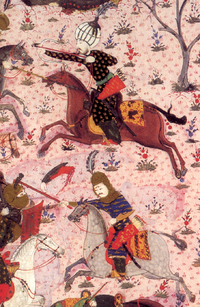
Nezim Frakulla
Encyclopedia
Nezim Frakulla alternatively known as Nezim Berati or Ibrahim Nezimi, was the first major poet among the Bejtexhinj, popular poets in the Muslim
tradition who wrote in Albanian
but used Arabic script. He was born in the village of Frakull
near Fier
and lived part of his life in Berat
. Frakulla studied in Istanbul where he wrote his first poetry in Turkish
, Persian
and perhaps Arabic, including two divan
s. About 1731, he returned to Berat where he is known to have been involved in literary rivalry with other poets of the period, notably with Imam Ali, mufti of Berat. Between 1731 and 1735 he composed a divan and various other poetry in Albanian, including an Albanian-Turkish mini-dictionary in verse form. Although we do not possess the whole of the original divan, we do have copies of ca. 110 poems from it. Some of his verse was put to music and survived the centuries orally. Nezim Frakulla asserts that he was the first person to compose a divan
in Albanian.
 Frakulla’s divan includes verse ranging from panegyrics on local Pasha
Frakulla’s divan includes verse ranging from panegyrics on local Pasha
s and military campaigns, to odes on friends and patrons, poems on separation from and longing for his friends and lovers, descriptions of nature in the springtime, religious verse and, in particular, love lyrics. The imagery of the latter ghazal
, some of which are devoted to his nephew, is that of Arabic, Persian and Turkish poetry with many of the classical themes, metaphors and allusions.
Muslim
A Muslim, also spelled Moslem, is an adherent of Islam, a monotheistic, Abrahamic religion based on the Quran, which Muslims consider the verbatim word of God as revealed to prophet Muhammad. "Muslim" is the Arabic term for "submitter" .Muslims believe that God is one and incomparable...
tradition who wrote in Albanian
Albanian language
Albanian is an Indo-European language spoken by approximately 7.6 million people, primarily in Albania and Kosovo but also in other areas of the Balkans in which there is an Albanian population, including western Macedonia, southern Montenegro, southern Serbia and northwestern Greece...
but used Arabic script. He was born in the village of Frakull
Frakull
Frakull is a municipality in the Fier District, Fier County, southwestern Albania....
near Fier
Fier
Fieri is a city in southwest Albania, in the district and county of the same name. It is located at , and has a population of 82,297 . Fier is from the ruins of the ancient Greek city of Apollonia.-History :...
and lived part of his life in Berat
Berat
Berat is a town located in south-central Albania. As of 2009, the town has an estimated population of around 71,000 people. It is the capital of both the District of Berat and the larger County of Berat...
. Frakulla studied in Istanbul where he wrote his first poetry in Turkish
Turkish language
Turkish is a language spoken as a native language by over 83 million people worldwide, making it the most commonly spoken of the Turkic languages. Its speakers are located predominantly in Turkey and Northern Cyprus with smaller groups in Iraq, Greece, Bulgaria, the Republic of Macedonia, Kosovo,...
, Persian
Persian language
Persian is an Iranian language within the Indo-Iranian branch of the Indo-European languages. It is primarily spoken in Iran, Afghanistan, Tajikistan and countries which historically came under Persian influence...
and perhaps Arabic, including two divan
Diwan (poetry)
-Etymology:The English usage of the phrase Diwan Poetry comes from the Arabic word diwan , which is loaned from Persian means designated a list or register. The Persian word derived from the Persian dibir meaning writer or scribe...
s. About 1731, he returned to Berat where he is known to have been involved in literary rivalry with other poets of the period, notably with Imam Ali, mufti of Berat. Between 1731 and 1735 he composed a divan and various other poetry in Albanian, including an Albanian-Turkish mini-dictionary in verse form. Although we do not possess the whole of the original divan, we do have copies of ca. 110 poems from it. Some of his verse was put to music and survived the centuries orally. Nezim Frakulla asserts that he was the first person to compose a divan
Divan
A divan was a high governmental body in a number of Islamic states, or its chief official .-Etymology:...
in Albanian.

Pasha
Pasha or pascha, formerly bashaw, was a high rank in the Ottoman Empire political system, typically granted to governors, generals and dignitaries. As an honorary title, Pasha, in one of its various ranks, is equivalent to the British title of Lord, and was also one of the highest titles in...
s and military campaigns, to odes on friends and patrons, poems on separation from and longing for his friends and lovers, descriptions of nature in the springtime, religious verse and, in particular, love lyrics. The imagery of the latter ghazal
Ghazal
The ghazal is a poetic form consisting of rhyming couplets and a refrain, with each line sharing the same meter. A ghazal may be understood as a poetic expression of both the pain of loss or separation and the beauty of love in spite of that pain. The form is ancient, originating in 6th century...
, some of which are devoted to his nephew, is that of Arabic, Persian and Turkish poetry with many of the classical themes, metaphors and allusions.
External links
- Nezim Frakulla's Divans in Albanian Aljamiado
- Albanian authors in translation by Robert Elsie
- Nezim Frakulla's biography and works translated by Robert Elsie
- Official website of Robert Elsie

